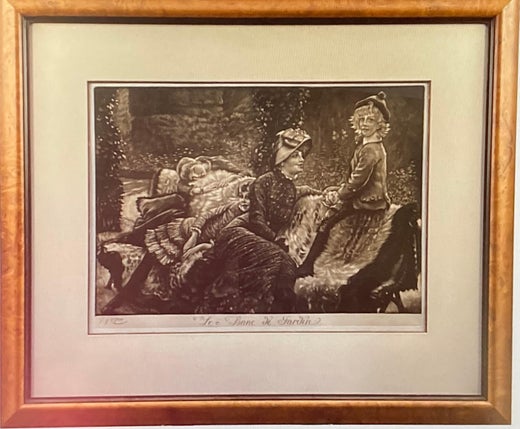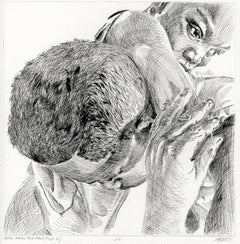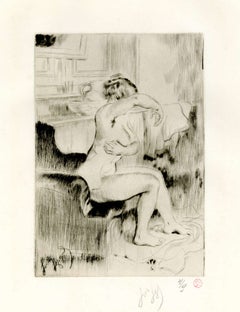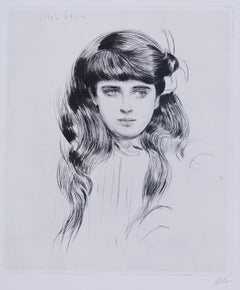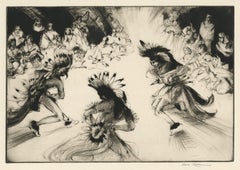Want more images or videos?
Request additional images or videos from the seller
1 of 5
James Jacques Joseph TissotLa Soeur ainee The Elder Sister1881
1881
Price:$2,000
$2,700List Price
About the Item
- Creator:James Jacques Joseph Tissot (1836-1902, French)
- Creation Year:1881
- Dimensions:Height: 11.875 in (30.17 cm)Width: 6 in (15.24 cm)
- Medium:
- Movement & Style:
- Period:
- Condition:
- Gallery Location:Fairlawn, OH
- Reference Number:Seller: FA113631stDibs: LU14015362562
James Jacques Joseph Tissot
Jacques Joseph Tissot (French: [tiso]; 15 October 1836 – 8 August 1902), Anglicized as James Tissot (), was a French painter and illustrator. He was a successful painter of Paris society before moving to London in 1871. He became famous as a genre painter of fashionably dressed women shown in various scenes of everyday life. He also painted scenes and figures from the Bible.
About the Seller
5.0
Recognized Seller
These prestigious sellers are industry leaders and represent the highest echelon for item quality and design.
Platinum Seller
Premium sellers with a 4.7+ rating and 24-hour response times
Established in 1978
1stDibs seller since 2013
815 sales on 1stDibs
Associations
International Fine Print Dealers Association
Authenticity Guarantee
In the unlikely event there’s an issue with an item’s authenticity, contact us within 1 year for a full refund. DetailsMoney-Back Guarantee
If your item is not as described, is damaged in transit, or does not arrive, contact us within 7 days for a full refund. Details24-Hour Cancellation
You have a 24-hour grace period in which to reconsider your purchase, with no questions asked.Vetted Professional Sellers
Our world-class sellers must adhere to strict standards for service and quality, maintaining the integrity of our listings.Price-Match Guarantee
If you find that a seller listed the same item for a lower price elsewhere, we’ll match it.Trusted Global Delivery
Our best-in-class carrier network provides specialized shipping options worldwide, including custom delivery.You May Also Like
Coentes Slip, NY
By Frederick Leo Hunter
Located in Middletown, NY
Etching with drypoint on hand made laid Japan paper with a deckle edge, 8 9/16 x 11 5/8 inches (220 x 296 mm), full margins. Signed, dated and titled in pencil in the margin, recto. ...
Category
Late 19th Century Victorian Landscape Prints
Materials
Laid Paper, Handmade Paper, Drypoint, Etching
A Breach of Promise - Hand Colored Etching on Paper 1900 Victorian
By James Dobie
Located in Soquel, CA
Victorian-style drypoint etching by James Dobie (British, 1849-1911), after a painting by Walter Dendy Sadler. Printed in London by J. Brooker & Co. and ha...
Category
Early 20th Century Victorian Figurative Prints
Materials
Paper, Watercolor, Drypoint, Etching
$920 Sale Price
20% Off
H 26 in W 21.25 in D 0.75 in
Orpheus. Drypoint print, Black & white, Blue, Polish artist
By Ewa Kutylak
Located in Warsaw, PL
Contemporary figurative monochromatic mezzotint print by Polish artist Ewa Kutylak. Print depicts a wanderer with a lantern going down the road. On the left there is a mysthical crea...
Category
Early 2000s Contemporary Figurative Prints
Materials
Paper, Drypoint
Don Kichote attacking. Figurative Drypoint Etching Print, Colorful, Polish Art
By Czeslaw Tumielewicz
Located in Warsaw, PL
Colorful figurative drypoint print by Polish artist Czeslaw Tumielewicz. Artwork depicts two people kissingDon Kichote on a horse, attacking a surreal windmill. They are shown in rat...
Category
2010s Contemporary Figurative Prints
Materials
Paper, Drypoint
A concert. Mezzotint print, Limited edition, Monochromatic, Polish artist
By Ewa Kutylak
Located in Warsaw, PL
Contemporary figurative monochromatic mezzotint print by Polish artist Ewa Kutylak. Print depicts a man sitting near a tree with a bird standing on his hand. There is a dog on the ot...
Category
Early 2000s Contemporary Figurative Prints
Materials
Paper, Drypoint, Mezzotint
$413
H 9.06 in W 4.93 in
A river. Drypoint print, Limited edition, Black and white, Polish artist
By Ewa Kutylak
Located in Warsaw, PL
Contemporary figurative black and white drypoint and copperplate print by Polish artist Ewa Kutylak. This surrealistic print depicts a man watering a river, there are fish in the wat...
Category
Early 2000s Contemporary Figurative Prints
Materials
Paper, Drypoint, Mezzotint
$413
H 5.52 in W 5.52 in
Flight above manor. Figurative Etching Print, Black and white, Polish Art
By Czeslaw Tumielewicz
Located in Warsaw, PL
Black and white figurative drypoint etching print by Polish artist Czeslaw Tumielewicz. Artwork depicts three people flying above a residency. There is moon, sun and a sea in the bac...
Category
2010s Contemporary Figurative Prints
Materials
Paper, Drypoint
A meeting. Mezzotint print, Limited edition, Black & white, Polish artist
By Ewa Kutylak
Located in Warsaw, PL
Contemporary figurative black & white mezzotint and drypoint print by Polish artist Ewa Kutylak. Print depicts a man facing a horse. Above them there is a dog in a landscape and bene...
Category
Early 2000s Contemporary Figurative Prints
Materials
Drypoint, Paper, Mezzotint
$354
H 3.15 in W 5.12 in
Untitled
By Ahmed Alsoudani
Located in Milano, MI
Color hard ground etching with aquatint, spit-bite aquatint, drypoint, roulette, and scraping and burnishing ed-30
Category
2010s Figurative Prints
Materials
Drypoint, Etching, Aquatint
Dalliance - XXI Century, Figurative & abstract drypoint print, Black & white
By Leszek Rózga
Located in Warsaw, PL
LESZEK RÓZGA (1924-2015)
He studied painting at Maria Skarbek-Kruszewska private atelier in 1945-46. In 1948, he began studies at the art school in Łódź (later: Academy of Fine Arts)...
Category
Early 2000s Contemporary Figurative Prints
Materials
Paper, Drypoint
More From This Seller
View AllBare Arms (The Practice #2)
By Darius Steward
Located in Fairlawn, OH
Bare Arms (The Practice #2)
Drypoint on Aluminum, 2019
Signed with initials lower right
Edition: 8 impressions (all uncolored), this “6 out of 8”
There are also 4 AP, 2 with hand coloring
Printed on Twinrocker all purpose paper
Published by Thomas French Fine Art...
Category
2010s Contemporary Figurative Prints
Materials
Drypoint
La Toilette
By Louis Legrand
Located in Fairlawn, OH
La Toilette
Drypoint, 1908
Signed and numbered in pencil by the artist (see photos)
Edition: 65 this state (35/65)
Published by Gustave Pellet (1859-1919),...
Category
Early 1900s Art Nouveau Figurative Prints
Materials
Drypoint
Portrait de petite fille, en buste, cheveux sur les epaules (Ellen 14 ans)
By Paul César Helleu
Located in Fairlawn, OH
Portrait de petite fille, en buste, cheveux sur les epaules (Ellen 14 ans) Portrait of a little girl, bust, hair on shoulders)
Drypoint, 1902
Signed lower right corner
Very small ed...
Category
Early 1900s Art Nouveau Figurative Prints
Materials
Drypoint
Indian Friendship Dance
By Gene Kloss
Located in Fairlawn, OH
Indian Friendship Dance
Drypoint, 1953
Signed in pencil lower right, (see photo)
Edition 200
Published by The Society of American Graphic Artists, New York
An impression is in the collection of SAAM, Washington and RISD Museum,
Condition: Excellent
Very rich impression with burr and selective whiping of the ink for atmospheric nocturnal effect.
Image/Plate size: 8 3/16 x 11 15/16 inches
Sheet size: 11 1/8 x 17 inches
Reference: Kloss 450
"'Indian Friendship Dance' is an eloquent statement of something which Gene Kloss has both observed and participated in. It is an Indian dance that is thought of as entertainment, rather than ceremony, but it is essentially an idea expressed in action, and an idea that has universal meaning. The young men who dance wear costumes of exquisite workmanship, intricately wrought with beads and feathers and subtle combinations of colors. The dancers are trained from childhood but develop their own steps and exhibit distinctive strength and grace. Singers and a tom-tom accompany the dance and since it usually takes place at night, a campfire is the source of light. The conclusion occurs when all the onlookers, old and young and from many places, join hands with the dancers in a slow revolving movement, while those who can, sing the difficult but meaningful Indian song that flows with the rhythmical dance step and speaks of fellowship, brotherhood, friendship." - An excerpt from a descriptive statement, written by Lynd Ward, and distributed with the drypoint at the time of publication." Courtesy Old Print Shop
Born Alice Glasier in Oakland, CA, Kloss grew up amid the worldly bustle of the San Francisco Bay Area. She attended the University of California at Berkeley, graduating with honors in art in 1924. She discovered her talents in intaglio printmaking during a senior-year course in figurative drawing. The professor, Perham Nahl, held up a print from Kloss’ first plate, still damp from the printing process, and announced that she was destined to become a printmaker.
In 1925, Gene married Phillips Kloss, a poet and composer who became her creative partner for life. The match was uncanny, for in her own way Gene, too, was a poet and a composer. Like poetry, her artworks capture a moment in time; like music, her compositions sing with aesthetic harmony. Although she was largely self-taught, Kloss was a printmaking virtuoso.
On their honeymoon the Klosses traveled east from California, camping along the way. They spent two week is Taos Canyon – with a portable printing press cemented to a rock near their campsite – where Gene learned to appreciate the wealth of artistic subject matter in New Mexico. The landscape, the cultures, and the immense sky left an indelible impression on the couple, who returned every summer until they made Taos their permanent home 20 years later.
Throughout her life, Kloss etched more than 625 copper plates, producing editions ranging from five to 250 prints. She pulled every print in every edition herself, manually cranking the wheel of her geared Sturges press until she finally purchased a motorized one when she was in her 70s. Believing that subject matter dictated technique, she employed etching, drypoint, aquatint, mezzotint, roulette, softground, and a variety of experimental approaches, often combining several techniques on the same plate. She also produced both oil and watercolor paintings.
Kloss’ artworks are filled with drama. Her prints employ striking contrasts of darkness and light, and her subjects are often illuminated by mysterious light sources. Though she was a devout realist, there is also a devout abstraction on Kloss’ work that adds an almost mythical quality.
For six decades Kloss documented the cultures of the region-from images of daily life to those of rarely seen ceremonies. She and her husband shared a profound respect for the land and people, which made them welcome among the Native American and Hispanic communities. Kloss never owned a camera but relied instead on observation and recollection. Her works provide an inside look at the cultures she depicted yet at the same time communicate the awe and freshness of an outsider’s perspective.
Although Kloss is best known for her images of Native American and Penitente scenes, she found artistic inspiration wherever she was. During the early years of their marriage, when she and Phil returned to the Bay Area each winter to care for their aging families, she created images of the California coast. And when the Klosses moved to southwestern Colorado in 1965, she etched the mining towns and mountainous landscapes around her.
In 1970 the Klosses returned to Taos and built a house north of town. Though her artwork continued to grow in popularity, she remained faithful to Taos’ Gallery A, where she insisted that owner Mary Sanchez keep the prices of her work reasonable regardless of its market value. Kloss continued to etch until 1985, when declining health made printmaking too difficult.
From her first exhibition at San Francisco’s exclusive Gump’s in 1937 to her 1972 election to full membership in the National Academy of Design, Kloss experienced a selective fame. She received numerous awards, and though she is not as well known as members of the Taos Society of Artists...
Category
1950s American Realist Figurative Prints
Materials
Drypoint
Profile Bust of a Girl - Woman's Head in Profile (Havard)
By Elie Nadelman
Located in Fairlawn, OH
Profile Bust of a Girl - Woman's Head in Profile (Havard)
Drypoint, 1920
Unsigned (as issued)
From: The Drypoints of Elie Nadelman, 21 unpublished prints by the sculptor, proof from ...
Category
1920s American Modern Figurative Prints
Materials
Drypoint
Keresan Dancers
By Gene Kloss
Located in Fairlawn, OH
Keresan Dancers
Etching & drypoint, 1962
Signed lower right (see photo)
Inscribed lower left: "Artist's Proof Keresan Dancers"
Depicts Keresan speaking peoples at Sam Felipe Pueblo
Contemporary Puebloans are customarily described as belonging to either the eastern or the western division. The eastern Pueblo villages are in New Mexico along the Rio Grande and comprise groups who speak Tanoan and Keresan languages. Tanoan languages such as Tewa are distantly related to Uto-Aztecan, but Keresan has no known affinities. The western Pueblo villages include the Hopi villages of northern Arizona and the Zuni, Acoma, and Laguna villages, all in western New Mexico.
Born Alice Glasier in Oakland, CA, Kloss grew up amid the worldly bustle of the San Francisco Bay Area. She attended the University of California at Berkeley, graduating with honors in art in 1924. She discovered her talents in intaglio printmaking during a senior-year course in figurative drawing. The professor, Perham Nahl, held up a print from Kloss’ first plate, still damp from the printing process, and announced that she was destined to become a printmaker.
In 1925, Gene married Phillips Kloss, a poet and composer who became her creative partner for life. The match was uncanny, for in her own way Gene, too, was a poet and a composer. Like poetry, her artworks capture a moment in time; like music, her compositions sing with aesthetic harmony. Although she was largely self-taught, Kloss was a printmaking virtuoso.
On their honeymoon the Klosses traveled east from California, camping along the way. They spent two week is Taos Canyon – with a portable printing press cemented to a rock near their campsite – where Gene learned to appreciate the wealth of artistic subject matter in New Mexico. The landscape, the cultures, and the immense sky left an indelible impression on the couple, who returned every summer until they made Taos their permanent home 20 years later.
Throughout her life, Kloss etched more than 625 copper plates, producing editions ranging from five to 250 prints. She pulled every print in every edition herself, manually cranking the wheel of her geared Sturges press until she finally purchased a motorized one when she was in her 70s. Believing that subject matter dictated technique, she employed etching, drypoint, aquatint, mezzotint, roulette, softground, and a variety of experimental approaches, often combining several techniques on the same plate. She also produced both oil and watercolor paintings.
Kloss’ artworks are filled with drama. Her prints employ striking contrasts of darkness and light, and her subjects are often illuminated by mysterious light sources. Though she was a devout realist, there is also a devout abstraction on Kloss’ work that adds an almost mythical quality.
For six decades Kloss documented the cultures of the region-from images of daily life to those of rarely seen ceremonies. She and her husband shared a profound respect for the land and people, which made them welcome among the Native American and Hispanic communities. Kloss never owned a camera but relied instead on observation and recollection. Her works provide an inside look at the cultures she depicted yet at the same time communicate the awe and freshness of an outsider’s perspective.
Although Kloss is best known for her images of Native American and Penitente scenes, she found artistic inspiration wherever she was. During the early years of their marriage, when she and Phil returned to the Bay Area each winter to care for their aging families, she created images of the California coast. And when the Klosses moved to southwestern Colorado in 1965, she etched the mining towns and mountainous landscapes around her.
In 1970 the Klosses returned to Taos and built a house north of town. Though her artwork continued to grow in popularity, she remained faithful to Taos’ Gallery A, where she insisted that owner Mary Sanchez keep the prices of her work reasonable regardless of its market value. Kloss continued to etch until 1985, when declining health made printmaking too difficult.
From her first exhibition at San Francisco’s exclusive Gump’s in 1937 to her 1972 election to full membership in the National Academy of Design, Kloss experienced a selective fame. She received numerous awards, and though she is not as well known as members of the Taos Society of Artists...
Category
1960s American Realist Figurative Prints
Materials
Drypoint
